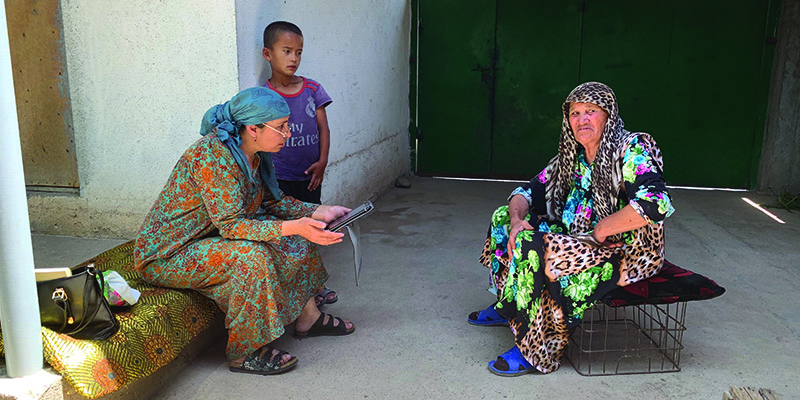
A fieldworker collects data for the eHCI in Tajikistan
The rugged, landlocked Central Asian country of Tajikistan is the latest nation to obtain vital funding to help shape its children’s future, thanks to human capability work being led by Professor Sally Brinkman.
In September 1991 – after more than 120 years of Russian control – Tajikistan declared independence following the collapse of the Soviet Union. Almost immediately, the new nation plunged into a five-year civil war that exacerbated its already poor economy, employment and living conditions and left the country in an almost complete state of devastation.
The pre-primary sector was one of many to be decimated. Countless preschool buildings were demolished and abandoned during the conflict. The post-war government, its hands tied by tight budgets, effectively deprioritised the sector while it focused on other aspects of recovery – leaving the country underprepared for the population boom that was to follow.
Throughout the 1990s and early 2000s Tajikistan’s birth rate exploded. The country is now in the top 25 per cent of the world’s fastest growing populations, with 17 per cent of the 9.5 million-strong Tajik population under the age of 6 and one in three aged under 15. The number of children aged 0–9 is expected to rise by nearly 23 per cent by 2025.
The parlous state of the preschool sector, however, has meant there are few places to send these children to support their social and emotional wellbeing and prepare them for primary education. For the past three years, Professor Sally Brinkman has been working with the government and World Bank in Tajikistan to help revive the focus on early childhood development and education.
The Early Human Capability Index (eHCI) she developed – a measure which helps countries quantify strengths and weaknesses in early childhood development (ECD) – has played a critical part in helping the country secure a US $73 million loan from the World Bank. The loan will help to increase take-up of a basic package of health and preschool education services for children aged 0–6 years, as part of the wider Build Tajikistan’s Human Capital Project.
In support of the loan bid, the eHCI was used to take a snapshot of Tajikistani children’s holistic development and readiness for primary education, and provide ideas for useful interventions and what is needed to implement them. Professor Brinkman and PhD student Alanna Sincovich flew to Tajikistan in 2019 to train dozens of fieldworkers to collect data using the index. The loan was granted in 2020 and – after some delays due to COVID – the preschool project is now under way.

“A big part of my work in countries like Tajikistan is defining and quantifying the problem in the first place, and then using those numbers for advocacy and to work with donors to bring in the cash to the project,” Professor Brinkman said.
Professor Sally Brinkman


“We then help them keep track of the projects and whether they’re delivering the intended results. In Tajikistan, we’ll redo the eHCI in three years’ time to see what changes might have occurred.”
Professor Brinkman said that given the overwhelmingly young population in Tajikistan, the country now has a unique opportunity to improve its future by investing in young people.
“Tajikistan has a wonderful chance to change its growth and development trajectory,” she said. “We know from the evidence that the best way to do that is by investing in ECD, including by improving child health, cognitive and psychosocial development, and access to and quality of education.
“Quality ECD investments pay high economic and social dividends. The project being funded by this World Bank loan is going to enable Tajikistan to really focus on that early childhood demographic and help lead to happier, healthier kids – which will in turn lead to a more educated, productive population in the future.”
